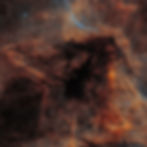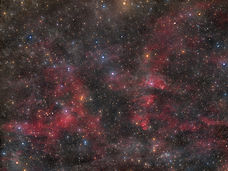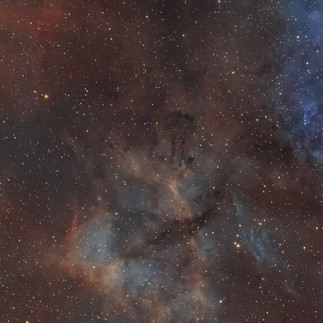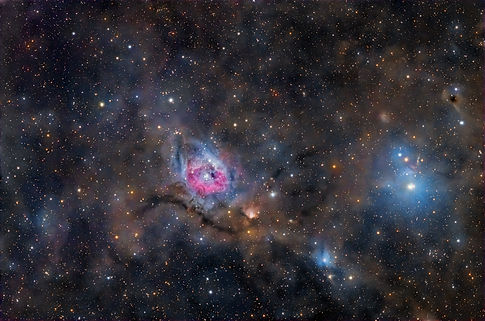Serpens Mosaic (feat. M16 & M17)

Spanning areas of the Serpens, Sagittarius, and Scutum Constellations, this three-panel mosaic captures a wide field that encompasses the Eagle Nebula (Messier 16) made famous by the Pillars of Creation image from the Hubble Space Telescope and the Swan Nebula (Messier 17). It also provides contextual views of several far less famous Sharpless objects—and one van den Bergh formation also manages to sneak into the frame. There’s even at least one supernova remnant and several catalogued dark nebulas in the image.
This is a very popular area among astrophotographers, and it’s rich with emission, dark, and reflective material. But it’s still a bit of a challenge to shoot from the Northern Hemisphere because it appears so low on the horizon. That means we typically only get a few hours per clear night with it. Nonetheless, there are many images of some of these objects taken from up North. What is a bit more rare is a wide-field mosaic of this nature that not only reveals good detail, but also presents the more famous targets in context.
Here are some brief descriptions of some of the more prominent objects in the field. There are other more detailed shots of these taken with larger telescopes on this site, but the little FSQ has acquitted itself quite nicely on these.

The most famous of the objects in the shot is the Eagle Nebula, M16. Just FYI, if you search for this, google “Messier 16,” not M16. Googling M16 will get results you may not expect! The interior of M16 contains the Pillars of Creation, one of the few astronomical images in history to create a cultural sensation. But they are only a small part of the Eagle Nebula, which is located about 7,000 light years away in Serpens.

The Swan is multicolored because of a high concentration of ionized oxygen in its core. Its one of the biggest star-forming regions in our galaxy and lies about 5,500 light years away in Sagittarius. It contains one of the youngest open star clusters in the galaxy at only one million years of age.

On the left side of the main image, you can make out the wispy blue filaments of SNR G017.8-02.6, a supernova remnant of unknown age or distance. This remnant has been studied along with many others to determine the contribution of supernovas to cosmic rays, but I can find no papers that deal with this supernova remnant in detail.

The 388th entry in Beverly Turner Lynds’ Catalogue of Dark Nebulae (LDN), LDN 388 looks like a stingray headed to the surface of a cosmic ocean. Others think it manifests as a hammerhead shark. Your impression of pareidolia may vary. Dark nebulas such as this one are typically cold, dense clouds of dust coated with carbon monoxide and nitrogen, which blocks light from passing through.
Sh2-44, 46, 47, 48, 50, 53, 54, 55 and vdB 122 (L to R, T to B)
The area is peppered with Sharpless HII emission regions that include the Eagle (Sh2-49), the Swan (Sh2-45), and eight others.
In the summer of 2025 I embarked on extending this mosaic southward, but it looks like I may not be able to complete that effort until 2026.

Finder Chart

Click to expand

Image Capture
Total integration: 47h 6m
Integration per filter:
- R: 1h 33m (93 × 60")
- G: 1h 29m (89 × 60")
- B: 1h 24m (84 × 60")
- Hα: 14h 50m (178 × 300")
- SII: 13h 55m (167 × 300")
- OIII: 13h 55m (167 × 300")
Coordinates: 18h 21m 0s · -14° 11′ 10″





























